Tamron Sp 70-200mm F/28 Di Vc Usd G2 Lens for Canon Ef Review

There are few lenses more indispensable to photographers equally a 70-200mm f/2.8 lens. Though large, heavy, and expensive, these lenses can be establish in the bags of many, many photographers, both professional and apprentice. They are just and then versatile! They can do everything, from events to sports to portraits to landscapes to everyday capture. Wait at the sidelines of whatsoever sporting result and yous will see them. Ditto for about weddings. Tamron's previous generation 70-200mm f/2.8 VC USD lens (internal code A009) was an excellent, underrated lens. Canon's own seventy-200mm f/2.8L IS II has long been considered one of the best lenses out at that place, period, and the fact that Tamron's A009 was a bit sharper at many focal lengths (until virtually 140mm or and then) and had an overall nicer rendering was met with some disbelief. While that lens has done reasonably well, information technology has never been a sales leader when compared to the start party lenses. It was mostly purchased by those that felt they couldn't afford the more expensive Nikon and Canon versions. I doubtable that Tamron's newest offering, the SP 70-200mm f/2.eight Di VC USD G2 (the A025), will brand a bigger splash for a few important reasons: Build, Image Quality, Focus, and Price. Of those four, Tamron had claim already to price and was competitive on image quality, merely the outset political party lens had the advantage in build and focus quality. Has Tamron eliminated the kickoff political party advantages with the A025 (G2) lens?
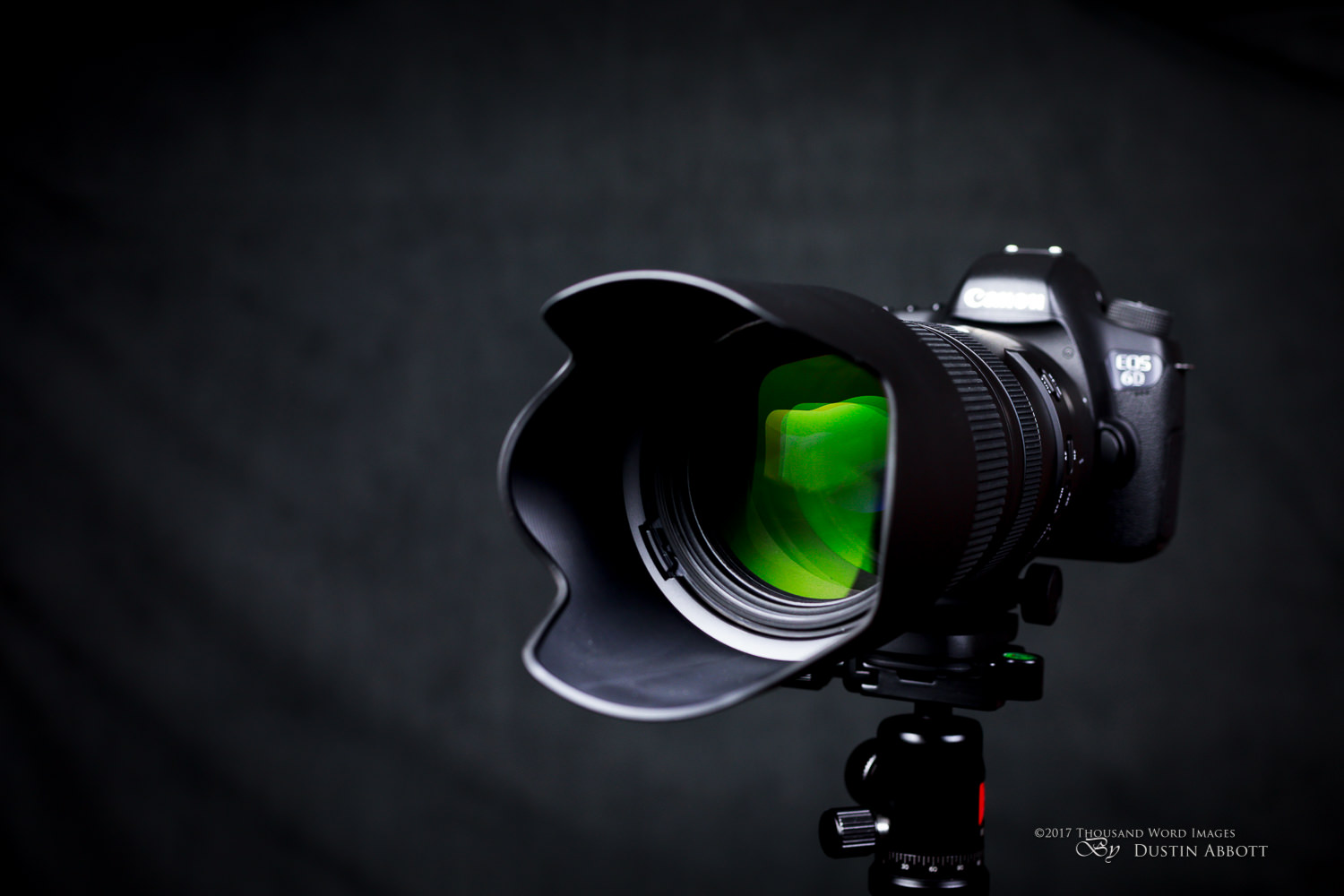
Prefer to watch your reviews? I've got you covered! Check out my full video review of the new Tamron 70-200 G2 lens!
Build Quality
Tamron has really been impressing with their contempo lens releases. There has been a shift abroad from budget "shells" around pretty expert eyes to now housing those optics in premium bodies. The new A025 is a not bad case in point, every bit the build grade is as good as the first party alternatives but in a sleeker, more mod finish.

I watched with interest equally Matt Granger did his unboxing of the lens on YouTube (I hadn't however received one), and noted that his initial reaction to the lens was that it was smaller than the previous generation lens when in fact it is really a bit larger. Information technology is heavier (3.31 lb/1500g vs. 3.24 lb/1470g) and longer (7.six"/193.04mm vs. 7.41"/188.3mm), though both increases are minimal and the lens is notwithstanding a pilus shorter than the Canon 70-200mm f/2.8L II (7.8"/198mm). But the sleek, mod design of the new lens makes it seem much smaller than what it is. I sympathize completely how Matt feels, as I had the same initial impression when unboxing the lens. It seemed smaller than expected, and that speaks to the sleekness of the new design. For applied purposes both increases are and then incremental as to be unnoticeable, only for that very slight increment in length and weight we go major improvements in build and performance.
There wasn't anything wrong with the build of the previous generation 70-200 VC lens (A009). It was mostly metal with a polycarbonate (engineered plastics) vanquish and I used one professionally for about three ½ years and just recently sold it. The lens still looked like new. Merely information technology did feel a step back from the heavier grade construction of the Canon version. The new lens (A025) is a nice step frontward, with a far more than modernistic design and a fully metal trunk (a lightweight aluminum). I've been really impressed with the build of Tamron'south recent SP line, and this lens is no exception. It feels very nicely made, and the weather condition sealing has all been upgraded over the previous generation. In that location was a gasket virtually the lens mountain on the A009 lens and a nod towards weather resistance, merely the A025 takes weather resistance to a new level with the addition of internal seals throughout the lens along with an expensive fluorine blanket on the front element to protect against h2o and fingerprints.
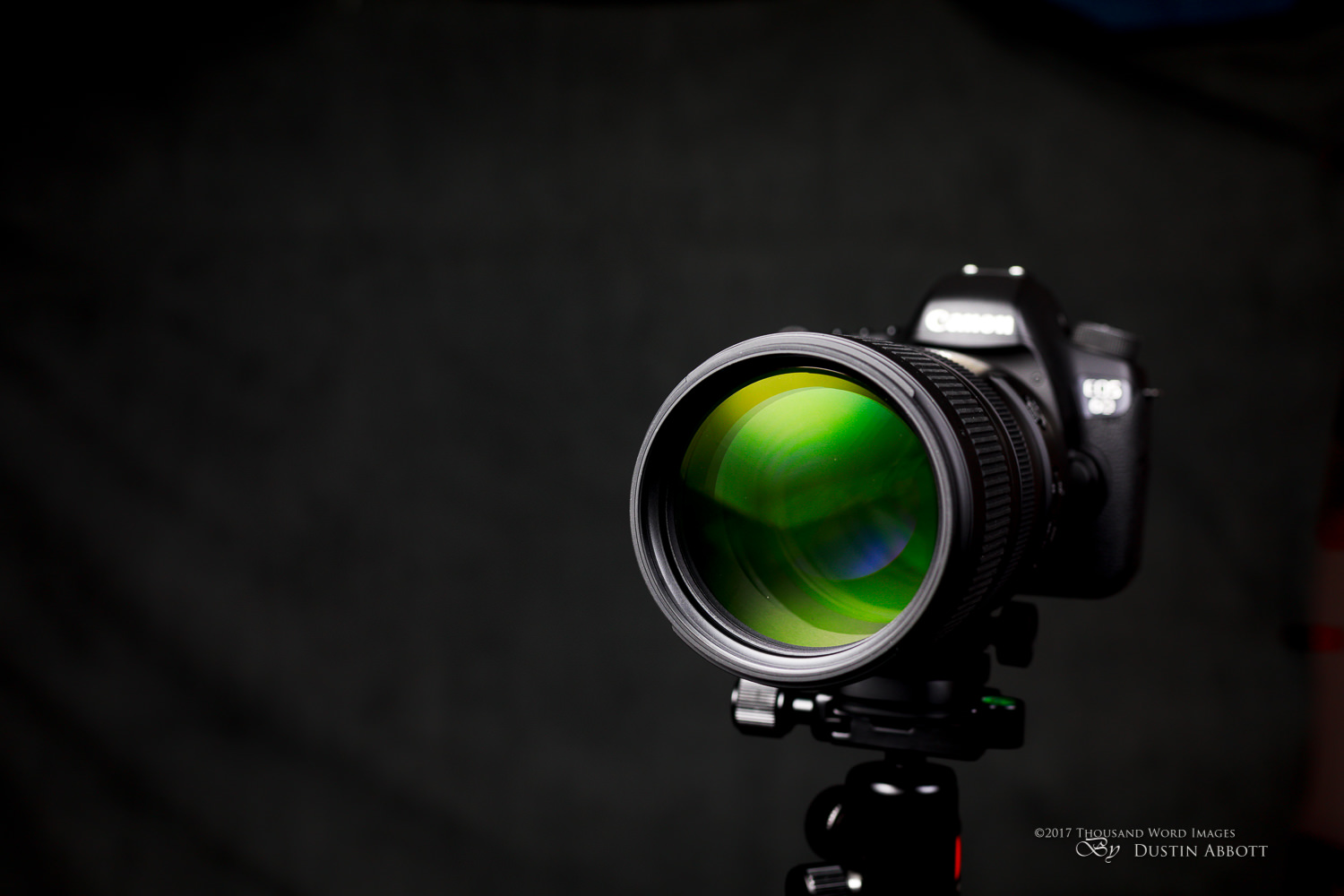
Lenses with this coating are much easier to make clean and it provides some extra protection. The lens feels great in the hand, and looks much, much more than modern than the four year development bicycle between the two lenses indicates.
When compared side by side, the Catechism 70-200L Ii definitely looks somewhat dated, with the Tamron looking far sleeker and more mod. The "Prototype Stabilization" gold bluecoat on the Canon lens strikes me equally garish and dated in item( the 100-400L II in my drove looks similar at a glance but more modernized when viewed more carefully). Some people prefer the college visibility of Canon's white lenses, but I personally prefer the lower profile look of blackness lenses. The 70-200L 2 is a very well built lens, but in terms of pure appearance it "looks" cheaper" compared to the sleek, metallic good looks of the A025. Pattern sensibilities across the lath have changed and the 70-200 G2 reflects these changes.
The A025 has metal filter threads in the a very mutual 77mm size (shared with the previous gen lens and the Catechism). Internally there 9 rounder aperture blades that retain a nicely circular shape when stopped down.
The zoom ring is located toward the front of the lens, and my preference is for the zoom ring to be the closer to the lens mountain. This is unchanged from the A009, all the same, as is the fact that the lens the focus and zoom rings move in the "Nikon" rather than "Canon" management. This latter fact is an issue for some, but non really one for me. I only don't personally observe it in the field, so my mind must subconsciously make the adjustment. Perhaps using then many different lenses makes this a non-issue for me. The action on both rings is fine, with the zoom band showing the nice smoothness common to internally zooming lenses. The damping is even and there are no sticking points, with the weight on the medium rather than light side (non really a "one-finger" operation). The zoom ring is slightly more than narrow than the previous generation lens (though still squeamish and piece of cake to discover) and has a single ribbed design rather than the more complex pattern on the previous lens. The tactile feel is a petty nicer, too. The manual focus ring moves smoothly, though as is usual with autofocusing lenses the feel is less precise and rewarding than that of a proficient transmission focus lens.
I do prefer the feel of both of the zoom and focus rings on the Canon; both of them are nice and wide and move extremely nicely. So, while I prefer the look of the Tamron lens, I do adopt the basic ergonomics of the Canon. It is tried and true…and it shows.
The A025 has four switches rather than the two on the A009. The A009 had simply the basics: AF/MF and On/Off for the VC. The A025 adds a focus limiter (always welcome) that allows y'all to cull betwixt the full range of focus or to limit the focus from iii meters to infinity (though this figure can be customized in Tamron's Tap In Console Utility if you have the Tap-In Console).
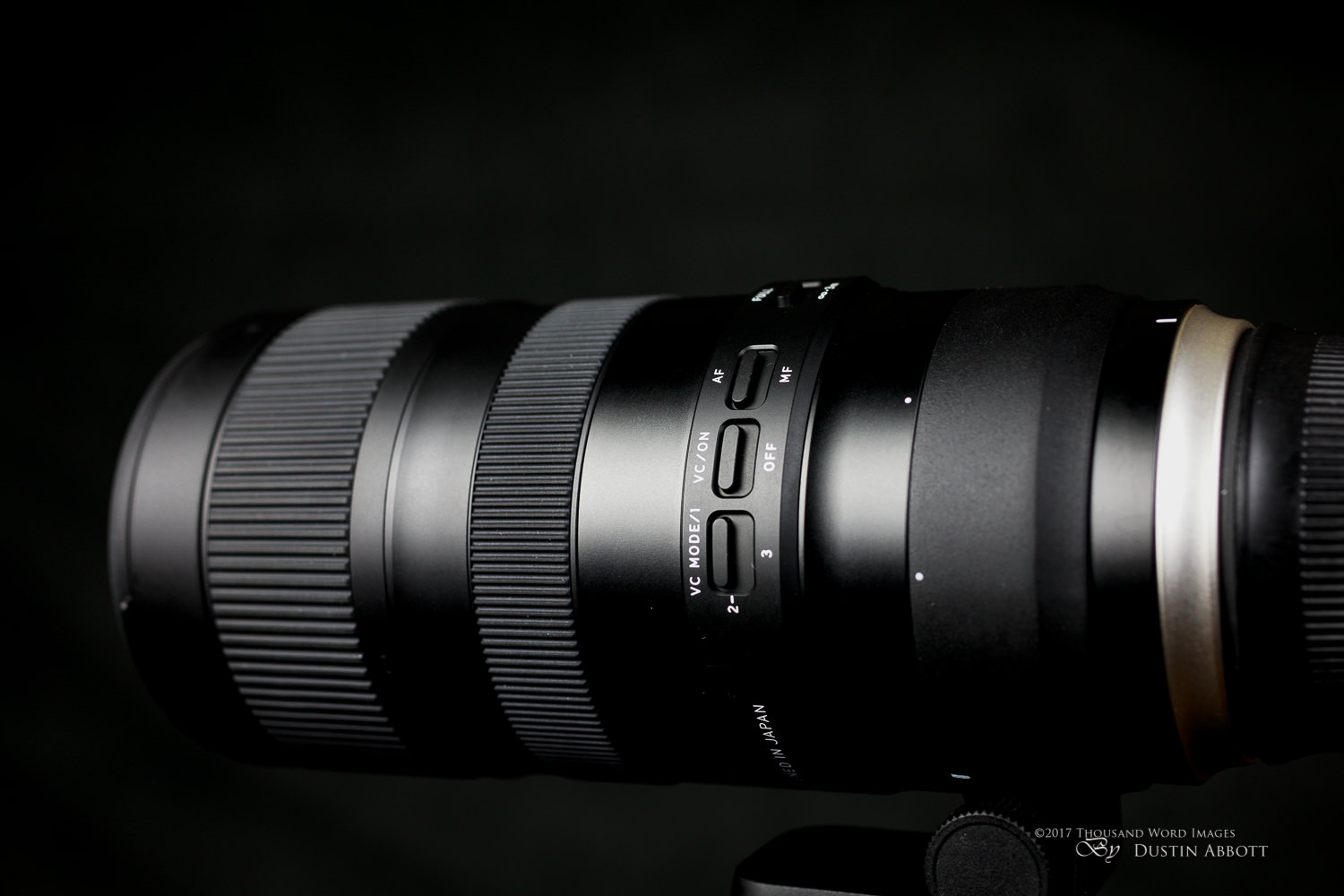
On that note, permit me say that I highly recommend picking up the Tap In even if y'all only use information technology use firmware updates to the lens. This saves time (never have to send the lens in to Tamron to have the firmware updated, as I had to do twice with the previous generation lens) and likewise helps future-proof your lens. Beyond this, however, the Tap In opens the door to a good bargain of customization of your lens, including tweaking the focus, setting the position of the focus limiter, changing the sensitivity of the manual focus override, and even selecting an boosted VC mode. Beyond this you too have the power to further tweak focus with either the new Tamron 1.4x and 2.0x teleconverters attached (completely separate values for either combination).
Using the focus limiter tin can help requite you a little extra speed when yous don't need to focus more than closely than 3 meters (roughly ten feet). The A025 tin can focus down quite closely (only 3.12'/0.95m), so you are eliminating a number of focus points between this and three meters.
The 4th switch on the lens gives y'all a choice of VC (Vibration Compensation/Epitome Stabilization) modes. Position 1 is the standard, balanced way that you will almost often use. Position 2 is for panning and limits the compensation to i axis allowing you to smoothly pan without intermission from the VC. Mode 3 (past default) is what Tamron calls "Capture Priority". It does little to stabilize the epitome in the viewfinder and instead prioritizes stabilizing the captured image. Tamron claims an industry leading 5 stops of stability in this mode (and in my tests it is the almost effective mode), which is neat, though those with shaky hands may find that stabilizing the viewfinder is worth likewise much to them to utilise this mode. By using the Tap In you tin can programme this 3rd mode to another pick, which is "Viewfinder Priority". This fashion is really designed for video, and changes the behavior of the VC to prioritize smoothen transitions for the VC coming on and off along with keeping the VC on a trivial longer to help produce smooth video footage.
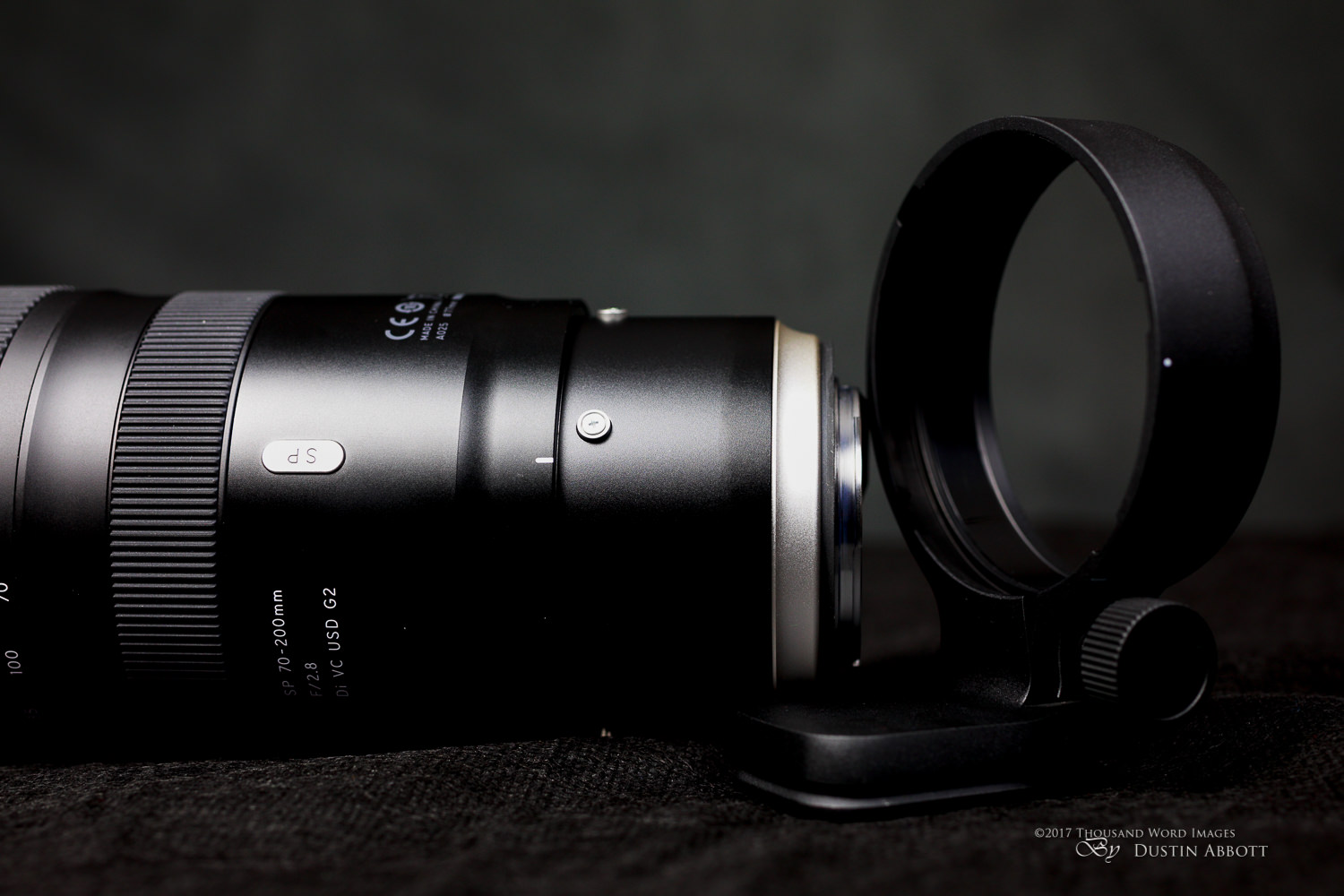
The tripod collar has also received a redesign. Information technology now has a unlike texture with a somewhat "matte" finish. Equally before it can exist rotated (with markings for the four points of the compass)) just is likewise fully removable. This latter point is a big one to me, as I primarily use a lens like this handheld and often remove the tripod collar to save a piffling weight. A major comeback is to the foot itself, which is now Arca-Swiss compatible, pregnant that on many tripods y'all tin simply mountain it correct onto the tripod without having to mess with a Quick Release plate or adapter. It'south one of those mutual sense touches that I'm e'er happy to see. I tested four lenses during this review cycles (two copies of the A025, ane of the A009, and the Canon) and was reminded on multiple occasions on how much I preferred the tripod pes of the A025, which made going on and off tripods for tests a breeze, while I had to take the time to thread on a quick release plate for the A009 or the Canon (which if yous leave on, makes everything that much more beefy and frequently means the lens won't "sit" right.)
Like other contempo Tamron releases the lens is designed in Japan simply produced in Tamron'due south plant in People's republic of china. My copy of their 85mm f/1.8 VC was fabricated in that same establish, and I've had good results with it, so my fears over moving the production out of Nihon have abated somewhat. There'due south no question that the new lens is beautifully congenital and has a gorgeous design. 70-200 lenses are workhorses, but there'due south no reason why they have to be ugly! The new Tamron 70-200 G2 gives the Catechism Fifty lens a run for its money in overall construction and definitely trumps it in the looks section.
A025 Autofocus Observations
There's no question that using Tamron's Tap In Panel allows one to produce a custom tuned focus effect on your camera trunk, simply exist forewarned that it is also a fairly time consuming procedure. You have the selection to calibrate the lens at three different focus distances (minimum focus, medium distance, and infinity) and at four unlike focal lengths (70, 100, 135, and 200mm). That is twelve different scale points, then not something I would want to exercise all the fourth dimension. It was a time consuming process to fully calibrate the lens, which I did.
Fortunately I found the lens' behavior during calibrating very comforting, equally information technology gave me repeatable results in multiple tests in Reikan FoCal (my calibration software of option) and also showed a linear design In adjustments as I moved from 70mm to 200mm. That consistently bodes well for those without a Tap In console, as yous should exist able to get a good result even when but calibrating the lens at the two focal lengths (70 and 200mm) that most modernistic photographic camera bodies allow for. The payoff for that laborious process was the lens has been exceptionally accurate for me in all lighting situations. I've used 2 unlike copies of the lens during this review period, and both copies focused very well for me.
Tamron has redesigned its USD motors with an additional microprocessor for added speed and accuracy (starting with the 85 VC). Information technology shows in the increased operation of the newer lenses, which are at present nearly equally fast equally get-go party competitors. Almost…
Much like the 85 VC, I find the seventy-200 G2 arrives quickly at the focus destination but then hesitates for a split second before locking focus. The Catechism focuses at about the same speed, but without the final hesitation at lock, making focus acquisition that split 2nd faster. The seventy-200L II is well known as one of Canon'southward better focusing lenses, so the fact that the Tamron stays close in both speed and accuracy is great to run across for a third party lens. I tested the lens on a Canon 5D Marking 4, Canon 6D, Canon 80D, and then via a Metabones Iv adapter on a Sony A7R 2. Unsurprisingly the best focus organization (5D Mark Four) gave the best results, with the increased voltage for focus making an obvious difference in "spool-upwardly" speed compared to the 6D, for case. Focus was unsurprisingly the slowest on the Sony/Metabones combination, though, for what it is worth, I really got faster results with the Tamron vs the Canon in that situation. On the DSLRs, withal, I give the overall focus speed win to the 70-200L 2, though the advantage is now very slight.
I used the lens on several dissimilar occasions in AF Servo manner and found the the lens had no problem making the continual minor focus changes necessary to rails activity. We are stuck hither between seasons (March) with it too cold (and nonetheless as well much snow on the ground) for fair atmospheric condition sports, simply with weather condition deteriorating for winter sports, so finding a lot of good action to track has been a challenge. I do have a very agile new kitten, though, then I spent some time tracking his play (which is a definitely a challenge due to the tight quarters). Still, I felt like results were very favorable.

Focus isn't as whisper quiet every bit Canon's new Nano USM, only is quiet in a USM kind-of-manner. There is a faint sliding sound on large focus changes, but everything is pretty repose overall – about the same as the seventy-200L 2.
Over my review period I was extremely pleased with the focus accurateness of the 70-200 G2. This is one area that Tamron seems to have figured things out, and my focus consistency with the 35 VC, 45 VC, 85 VC, and now the 70-200 G2 is on par with the equivalent Canon lenses. I shot in a wide variety of situations and lighting conditions and was very pleased with the results that I got.
Teleconverter Performance
I of the shortcomings of the A009 lens was that it was (co-ordinate to Tamron) not designed for compatibility with teleconverters. This was a competitive disadvantage, every bit Canon's ain lens is a very strong performer when used with teleconverters. Tamron has rectified that error here and designed this lens from the ground upward with compatibility with its new line of SP Teleconverters. I had both the ane.4x and 2x converters on hand, and they, like the remainder of the new lineup, are very sleek with metal construction and a weather sealing gasket nearly the lens mountain. They seem just as nice as the Canon i.4x Three version that I personally ain. You lot can view my detailed video review on the new teleconverters here.
In my internal conversations with Tamron representatives they stressed that Canon TCs should exist paired with Canon lenses, and Tamron TCs with Tamron lenses. This proved true in a number of different ways. The A025 focused fine with the Canon one.4x III that I have, for case, but the combination for some reason allows just a maximum aperture of [reported] f/5.vi rather than f/4 (using information technology on the Catechism lens allows f/4). Ditto in the opposite direction when I mounted the Tamron one.4x TC on the Canon lens. The maximum aperture will prove every bit f/5.6, only the effective discontinuity is actually f/4. Information technology's a reporting issue. You lot will too get a few other reporting quirks: the Tamron 1.4x extender is recognized as the Catechism 1.4x III on the photographic camera trunk (and in software), while the 2.0x extender volition almost never annals correctly in terms of discontinuity (and mayhap focal length) when paired with Canon lenses. On a carve up annotation, you will get a few quirks when pairing the TCs with the Tamron 150-600 G2 lens, only the behavior on the 70-200 G2 is pretty civilized.
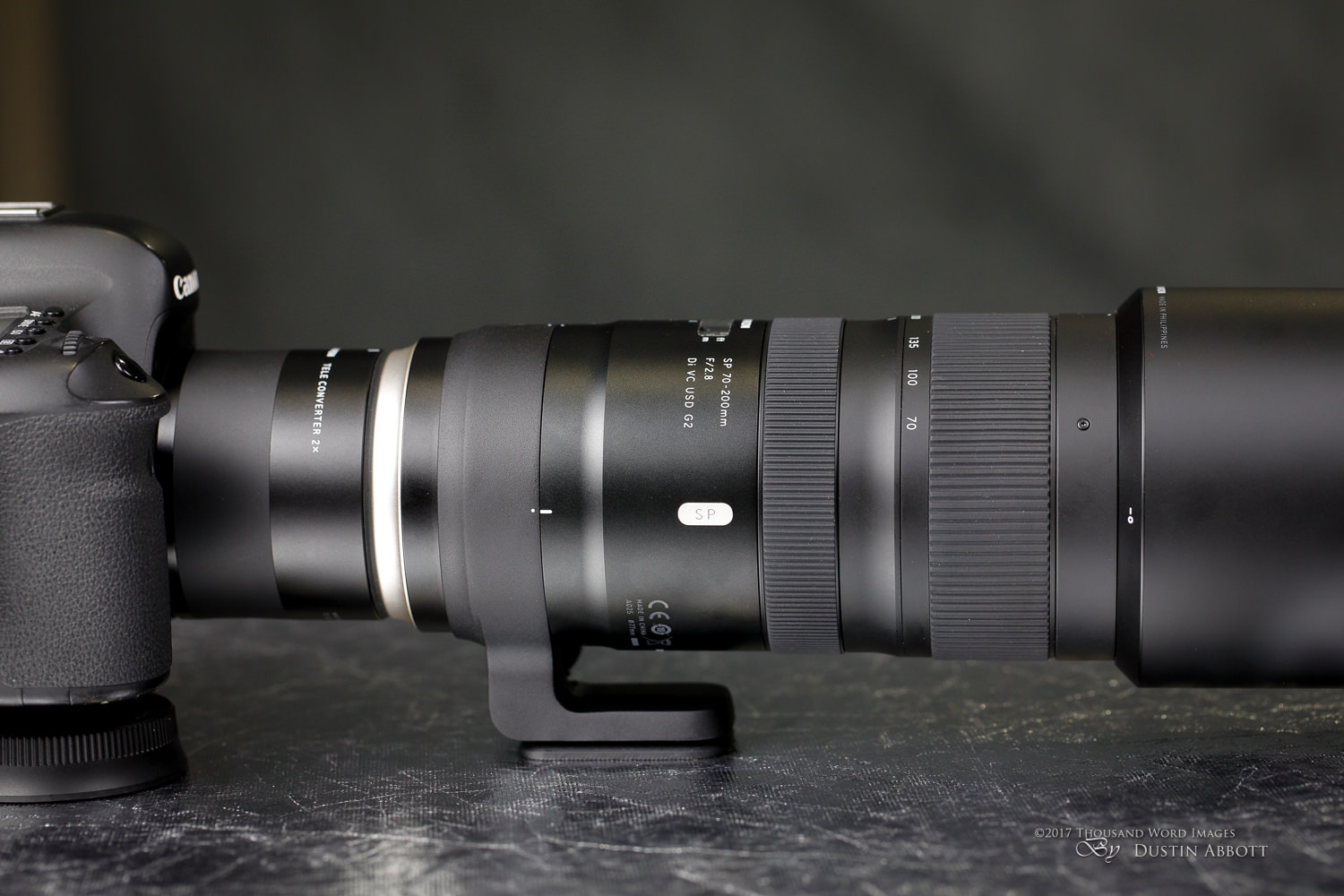
I will bargain more with the image quality in that section, simply I will note that my Catechism bodies registered the maximum aperture value correction with both TCs (f/iv with the ane.4x, and f/five.6 with the ii.0x) when paired with the seventy-200 G2. What doesn't always properly register is the new maximum focal length with the ii.0x; sometimes it volition show 400mm, but other times information technology will still bear witness the maximum focal length as 280mm. The reason for this is that the camera doesn't always recognize that it is a 2.0x extender, and volition often annals the two.0x as the Canon ane.4x III. Occasionally it will show 2x III and 400mm, merely not consistently and I can't see a design as to when it decides to record correctly or not. You are still going to get 400mm of reach (that doesn't change), just that information may not annals correctly in the camera body or the EXIF engagement.
In good low-cal I saw little impairment with either TC, with focus speed and conviction seeming to be pretty much like with the blank lens. In extremely dim light I saw just a niggling pulsing where there was little contrast to grab, but it did lock focus accurately in the stop. That's a definite improvement over the A009. The focus on the A009 didn't respond well to TCs at all. Mounting on the Tamron 1.4x extender on the Canon slowed it downwards a bit (particularly with large focus changes), but was usable. Mounting the Tamron ii.0x on the Catechism 70-200L II didn't produce a useable result. Information technology mostly pulsed, and merely after several seconds of pulsing did it decide to lock focus…fifty-fifty on higher contrast subjects. Switching back to the Tamron on Tamron combination was a nighttime and solar day improvement.

I'm not a big fan of 2.0x converters, myself, as I feel they introduce as well many compromises, but Tamron'southward 2.0x does seem to produce very good optical results. 200mm is the weakest point optically in the 70-200 G2's focus range, so unfortunately that is going to be reflected in use with TC's (where you are often going for the greatest attain). Final results are good, only not as good equally the Catechism with it's TCs (see more in the image quality section). Information technology is worth noting the Tamron Tap In Panel allows you to enter separate values for a lens with either the 1.4x or 2.0x attached, so if yous plan to employ a certain combination extensively yous can invest the time to assure maximum focus accurateness and the best results.
Information technology is worth noting that calculation extenders definitely improves the maximum magnification effigy of the 70-200 G2. The blank lens gives a magnification of right under 0.17x. Adding the 1.4x changes that figure to 0.25, while the 2.0x extender brings the magnification upward to around 0.33x. That final figure is pretty shut to the native magnification of the original Tamron lxx-200mm, which tells me that information technology must have strongly breathed in the opposite direction (like the 70-200L II except more so!)
I final tip if you plan to employ Tamron's extenders with the 70-200 G2: I found stopping downward i stop with the extenders attached gave a very overnice boost in image quality.It is worth noting that a lot of early buyers are giving negative reviews to the Tamron teleconverters. Information technology'south non because they aren't good (they are actually excellent), but rather because Tamron's promotional material has given some the faux impression that people are going to get quality autofocus with the converters + the Tamron 150-600mm G2 lens…which isn't true. This lens, yes, merely not the 150-600 G2. Watch my video on the teleconverters to go the whole story on them!
Improved Prototype Stabilization
Tamron's new VC works beautifully. Information technology operates more smoothly than the A009'southward VC, with smoother transitions on and off. I tested it using both Mode 1 (Standard) and Mode three (Capture Priority) at one/25th second, 1/xvth second, and 1/8th second. I too compared the Canon EF seventy-200L 2 on its Manner i (information technology has simply two modes and no equivalent Capture Priority mode). To make things more fair (considering the focus breathing of the Tamron and the target altitude of about 10.5 feet), I tried to friction match framing and thus shot the Canon at about 168mm.
| Lens (Mode) | 1/25th (out of five) | ane/15th (out of 5) | i/8th (out of five) |
| Tamron (i) | 4.five (1 slight blur) | 5 | ii (ish) |
| Tamron (three) | 5 | 5 | three (Perfect) |
| Catechism | 4.5 (ane slight blur) | 2.five-iii (ish) | 2 Perfect – three close |
Overall I was impressed with the operation of both lenses. In Mode one the Tamron does the all-time task of keeping the viewfinder steady, so if this is a large deal to you then the Tamron has an excellent performance. The value of Tamron'south Mode iii (though it does nada for the viewfinder) was seen equally the shutter speed dropped. It delivered the near consistent results overall, though I will note than in the last sequence its worse blur was a bit worse than the Canon's worse blur. I was surprised by the near identical performance of the Canon at 1/15thursday and i/8thursday. Information technology delivered pretty much the same results, which lagged backside the Tamron at 1/15th but pretty much matched it at 1/eightthursday second. Both of these lenses have fantastic image stabilization, only just know that there are very, very few situations where I would recommend shooting at even 1/15th second shutter speed with a telephoto lens; the chance of subject movement is too high. For everyday shooting and typical shutter speeds neither of these lenses will disappoint.
Here are a few examples of the 70-200 G2 at 1/8th second in Fashion 3:
In a serenity room with my ear near the butt I can hear faint whirring with both lenses, with the Tamron registering every bit a bit quieter. Neither lens' prototype stabilization produces enough racket to actually be noticeable backside the photographic camera.
70-200 G2 Epitome Quality
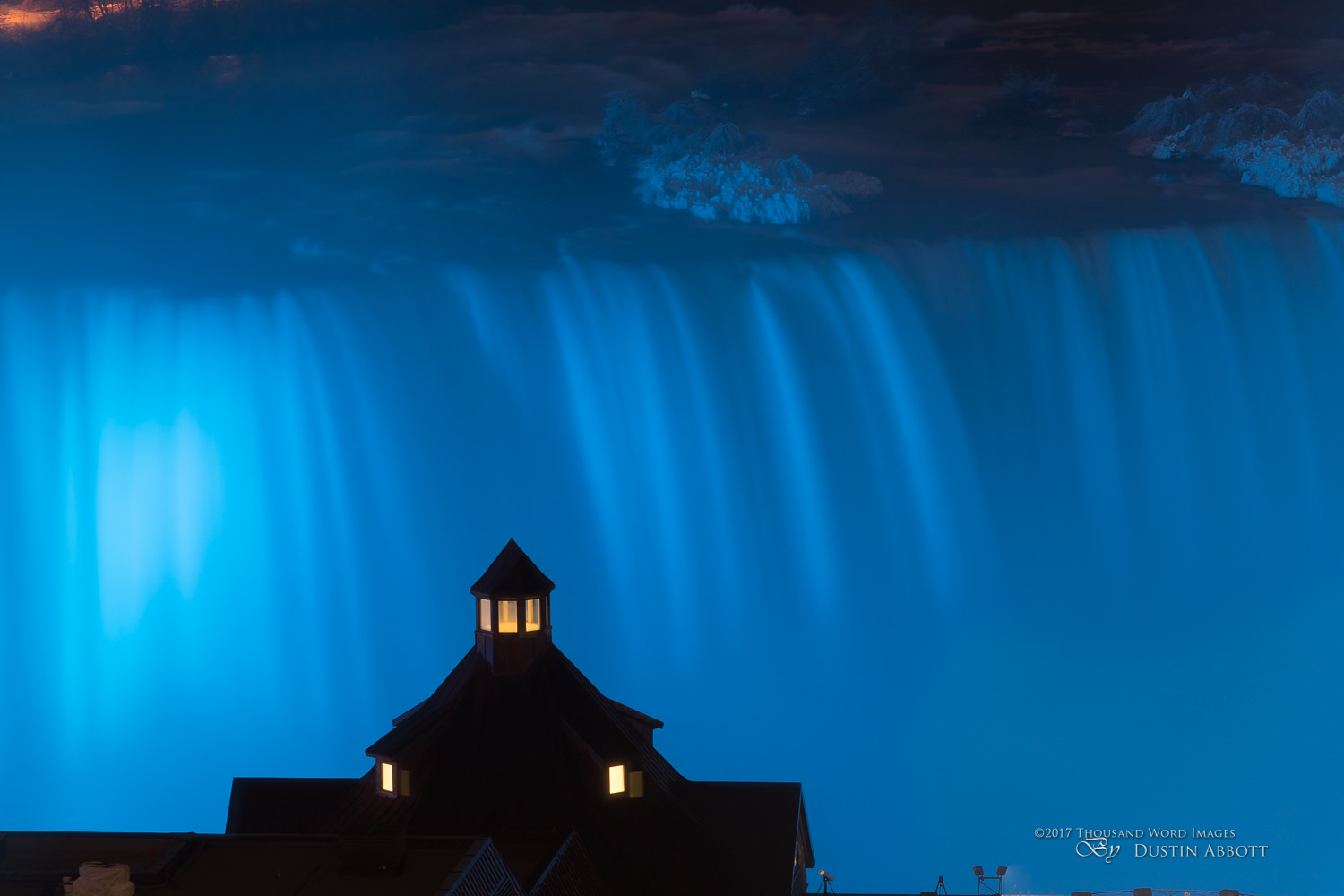
This is ever an area of priority for a new generation of lens. Equally we have seen, Tamron has done a keen chore of refining the autofocus, build, handing, and prototype stabilization of the lens, but have they had equal success with the image quality? Let's look at a number of different metrics to make that determination.I recommend that you lot visit the Lens Paradigm Gallery to come across many more than photos than what will fit in the review. I've got photos with extenders, on APS-C, on total frame, and even via adapter on a Sony A7R Two.
Sharpness and Resolution
Many don't know this, just Tamron'southward previous generation A009 really had a minor optical edge from seventy-135mm over the Canon 70-200L Two, with the Catechism lxx-200 giving the amend operation in the latter part of the range. What nosotros are going to notice is largely an expansion on that theme, where Tamron has built upon their existing strengths but not fully addressed their weaknesses. I used four lenses every bit a part of this test: two copies of the A025, the A009, and the Canon.You tin can picket my detailed analysis of the image quality in this video:
When comparing the two copies of the A025 I found that they performed pretty similarly, though ane was a bit better centered than the other and gave a more fifty-fifty performance on both sides of the frame.
At 70mm the lxx-200 G2 is the articulate winner. Information technology is crisp and detailed from corner to corner with very trivial resolution loss right out the very edges. At that place is no hint of haziness from a lack of contrast and no chromatic abnormality at all. The Canon is fairly good in the centre (though non as good equally the A025). Sharpness is expert but there is both more softness visible along with a hint of some majestic fringing. Towards the edges of the frame is a unlike story, however, with details becoming blurred somewhat by both a lack of contrast and more pronounced purple fringing. Stopping down to f/4 allows the middle of the Canon to almost catch upwards with the Tamron, just the Tamron edges are improve at f/2.eight than the Canon is even at f/5.half dozen. The A009 middle at 70mm (f/2.8) is close to the A025, but the edges lag behind the 70-200 G2 in an apparent style.
A025 vs Canon, 70mm f/2.8 (left, center, right)
A025 vs A009, 70mm f/two.8 (left, eye, right)
The situation is virtually the same at 100mm, with the Tamron lxx-200 G2 show a strong win on the edges but clearly amend towards the center, also. The Canon all the same suffers from some CA towards the edges. At f/4 the centers are pretty close merely there is still an obvious edge for the A025 towards the edges. The aforementioned pattern from 70mm is true for the A009; it is fairly close in the center merely lags towards the edges, so information technology is clear that on the wider cease of the focal range Tamron has worked virtually at extending resolution towards the edges.
A025 vs Canon, 100mm f/2.8 (left, center, right)
At 135mm the race tightens a fleck. Both the Tamron and the Canon show a near identical centre performance. Towards the edges the Catechism has managed to lose the chromatic aberrations that held it back at wider focal lengths, and while the Tamron still has a small advantage nearer the edges, it isn't virtually as pronounced anymore. With both lenses at f/four there is no real advantage to exist seen for either one. Here's a look at both sides:
I was also reviewing some other (secret) lens at the same fourth dimension, then I had an opportunity to compare both the A025 and the seventy-200L Two on the Sony a7R II via the Metabones IV adapter. I shot an outdoors comparison with the very high resolution a7RII at 135mm (or, in the case of the Canon, 140mm, as it is very hard to utilise the Canon's focal length markers in the middle of the range to accurately set a focal length…they are always off by a off-white margin). In this test (shots from about 90 feet away) there was some pocket-sized give and have across the frame just the Tamron was a slight winner overall showing greater contrast and texture resolution in more areas of the frame. The Tamron maintained its edge even with the lenses stopped downwardly. I discover information technology encouraging that the Tamron seems to smoothen when paired with a higher resolution sensor.
A025 vs Canon, 135mm f/2.8 (samples from beyond the frame)
The situation reverses at 200mm, nonetheless, and it is clear that the Canon is optimized for the long stop; a decision that is hard to fence with. The edge advantage is minimal only credible, with the Catechism have showing more precision on the fine engraved numbers on my vintage lenses that I use for these tests. The chromatic aberrations are long gone, and contrast is stiff. In the center the difference is roughly the aforementioned. The Tamron is skillful, merely the Canon is improve. The lenses are closest on the right side, but I still slightly adopt the Catechism's functioning. This isn't taking anything abroad from the Tamron, every bit it is delivering a keen performance, but when yous compare head to head (every bit I did) y'all will detect that the 200mm results show a slightly softer result for the 70-200 G2. There's a flake of "haze" due to reduced dissimilarity and slightly less resolution. Through f/v.6 the Tamron never really "catches up", either, as the lenses are really closest wide open. When I compared the A025 at f/ii.8 and f/v.6 I found that the results were pretty much the same with perhaps a slight border for the f/2.8 result. The A009 was about as adept in the eye at f/two.8 (as the A025), but the edge results showed a slight advantage for the A025.
A025 vs Canon, 200mm f/2.8 (left, center, right)
A025 vs A009, 200mm f/ii.8 (left, center, right – bottom tertiary of the frame)
If you are interested in seeing a resolution comparison on a loftier resolution 5DsR, I recommend looking at Bryan Carnathan'due south Lens Epitome Quality tool.
Here's a wait at a few other comparisons at 200mm shot on the Sony a7R 2. The infinity shot strongly favored the Canon, but a medium distance shot (tree trunk) seems to slightly favor the Tamron, which shows that out in the real globe at that place are a number of factors that ultimately affect resolution. The concluding shot is from the infinity shot at 200mm stopped downwards to f/5.vi, which shows parity between the lenses.
When the stars align, however, yous can become stunningly sharp results from the seventy-200 G2 fifty-fifty at it's weakest betoken: 200mm, f/2.viii. This is a crop from a much larger image.

I did a similar series on APS-C (Canon EOS 80D). While the trend was similar (Tamron delivered a stronger performance through 135mm with the Catechism the better at 200mm) I noticed 2 significant differences. Start was the fact that the Canon almost always matched the performance of the A025 in the middle of the frame simply not the edges. The center operation of the Canon was surprisingly skillful through the focal range fifty-fifty in the focal lengths where its edge functioning waned. I also noted that the chromatic aberrations were less pronounced on APS-C, which isn't always the instance. I've tested some lenses that showed little CA on full frame but a lot on APS-C, and then you just never know how a lens will handle that transition. The lxx-200 G2 shows no chromatic aberrations on either total frame or APS-C. Both lenses perform well on APS-C, but relatively I call back the Catechism does improve. Its optical weaknesses on the wider end are mitigated somewhat on APS-C, while its strengths (center of the frame and on the telephoto terminate) remain potent. If you are an APS-C shooter I recollect the Canon is the better pick optically. Only if you are buying the 70-200 G2, there'due south no reason to not use information technology on APS-C. Here's an example:

You can meet other APS-C results in this Paradigm Gallery.
Canon and Tamron have 2 unlike points of emphasis in their optical design. The Tamron provides a more fifty-fifty performance across the frame and throughout the focal range, but the Canon is optimized for the telephoto stop. Which arroyo is ameliorate will really depend on your shooting priorities. I find it very hard to call either lens the winner in this category, as they both accept articulate wins at different ends of the focal range. Neither volition disappoint optically.

The Canon being optimized for the 200mm focal length also means that it performs better with extenders attached. 200mm becomes 280 and 400mm, respectively. The Catechism remains impressively sharp with either a i.4x or 2.0x extender attached. The Tamron 70-200 G2 likewise does well with either extender, but the border sticks with the lens that has the stronger 200mm performance (since the signal is more attain), which is the Catechism. The Canon has a 2d advantage with the extenders at short to medium distances, which leads us to…
The Focus Breathing/Maximum Magnification Issue
Tamron'due south first 70-200 lens ready the bar very, very high in the magnification and focus animate metrics. They had Macro in the proper noun, and while that was a picayune ambitious, it did achieve a very impressive 1:3 (0.32x) maximum magnification ratio at the minimum focus distance of 3.12′ (95 cm). It was extremely useful for closeup shots, and could obviously completely blur backgrounds at those kinds of distances. The A009 was a much better lens in almost every way (MUCH faster autofocus, meliorate build, and the inclusion of VC), simply it also took a major pace backwards in this section to a disappointing 1:8 (0.125x) maximum magnification ratio at a minimum focus altitude of 51.2" (ane.iii m). The trouble? Tamron jammed a LOT more complication (five more than drinking glass elements in 4 more groups, a truthful band-type USM motor, plus a brand new Vibration Compensation arrangement) into a lens that was actually both shorter and narrower. Close focus is accomplished with space (the elements moving abroad from the sensor), but with less space available something had to give. I had owned the older Tamron seventy-200 lens briefly and appreciated the "macro" qualities, so it is this area that I was most disappointed in the newer VC lens (A009). When I heard the rumor of A025'southward proclamation I stated that this was one of the master areas that I was looking for improvement in.
Consider this a expert news/bad news report. The good news is that pretty much everything is improved relative to the A009, simply nowhere near the level of the old lxx-200. The minimum focus distance is definitely improved, and is now identical to that of the get-go generation lens at three.12' (95 cm). Wow! We should be back to that bully magnification effigy, right?
Not so fast. The old lens didn't negatively "focus breathe". Focus breathing occurs when the lens uses some of the focal length space to accomplish closer focus. It's a compromise to cram more than optical performance into a similarly sized lens. So while the A025 can focus down as closely as the erstwhile lens, it is still a more than circuitous optical motorcar with fifty-fifty more features crammed into a lens of like length (it gains 5mm over the A009). While the lens is a truthful 200mm at medium focus distance to infinity, near minimum focus it behaves more than similar a 165-170mm lens, and then the maximum magnification ratio is 1:half dozen.1 (0.163x). Definitely a more useful figure than the previous generation lens (0.125x), only nowhere nigh the 0.32x of the old lxx-200 nor even as skillful as the Canon'south 0.21x (achieved at a minimum focus altitude of 3.94'/1.2m).Here's a visual comparison with the Canon and with the A009
Some improvement, yes, just not as much as I'd hoped. The good news is that the lens gives an exceptional operation at minimum focus and the ability to focus down closely is very helpful not only for tight headshots but also shooting details at weddings or events. The Canon can't focus as closely, simply it too doesn't focus exhale (at least negatively), so information technology is fifty-fifty amend in these types of situations.
Yous can run into my video on the focus breathing issue here:
At distances brusk of infinity the framing between the A009 and the A025 is virtually identical (come across the sharpness comparisons higher up), then Tamron's focus breathing problem hasn't gotten worse, and information technology is competitive with nearly lenses, simply it doesn't fare well compared to the Catechism.
I ready upwards a exam with a tape measure to compare focus breathing at vi feet, 12 feet, and 18 feet. I shot with the Tamron and 200mm first, setting up my examination subjects to nigh touch the edge of the frame at both sides. I so zoomed the Catechism out until I get near identical framing with it. At 6 feet I needed to zoom dorsum to 146mm before I got equal framing, which indicates a significant amount of focus breathing at six feet (relative to the Canon).. At 12 feet the Canon was zoomed to 168mm. At 18 feet the Canon was at 182mm to reach the same framing. Space limited my moving further in my studio space, simply you can extrapolate that by 24 feet framing should be pretty close. When I shot at infinity I found the framing to be the aforementioned with both lenses.
When I released a video on this topic at that place were a number of people that directed me to tests that show that the Canon is actually longer than 200mm at close range (it breathes in the contrary direction and is more like 220-230mm), which exaggerates this difference. At close distance the Tamron probably behaves more like a 165-170mm lens in an absolute sense (because that the Canon breathes in the contrary direction). That being said, however, the Catechism is the main competitor (at least for Canon shooters), and so that remains an area of strength for it when compared to the Tamron.
What does this mean? It means that at close focus distances you lot produce a tighter head shot, for case. This comparison was shot at the aforementioned difference and both lenses set at 200mm:
It means that backgrounds will be more blurred because of great focal range pinch. The simply potential upside that I tin can come across is that if you are situation where yous are trying to fit more in the frame (and accept no room to back upward), you can really get more in the frame with the Tamron than the Catechism, every bit the Canon "breathes" in the opposite management and frames tighter than 70mm at closer focus distances – as this photo shows.
Some take recently intimated that this was a "tertiary party" problem, but that'south not truthful at all. Every new Canon telephoto zoom that I have reviewed recently has exhibited focus breathing, including the EF-Southward 55-250 STM, EF-M 55-200 STM, EF seventy-300 IS II, the 70-300L, and the otherwise incredible 100-400L 2. In fact, when I compare the 70-200 G2 + ii.0x @ 400mm to the 100-400L Ii @ 400mm I find that they frame very similarly (the Tamron is a couple of millimetres wider). Note that due to a reporting quirk it shows 280mm rather than 400mm for the for the seventy-200 lenses + two.0x combo.
The Catechism 70-200L II with the same 2.0x converter (400mm) frames noticeably tighter (see the 2d photograph above). Among the newer Canon offerings the older 70-200L II is really the exception to the rule. The trade off with the 100-400L Ii is that it focuses down incredibly close (3.v'/0.98m) and has an incredibly useful 0.29x. It focuses down much closer than the lens it replaces (v.9'/i.8m) to achieve a near fifty% increase in reproduction (0.20x for the older 100-400L).
I'm afraid that this is a office of modernistic lens design that tries to pack ever more complexity into similarly sized lens bodies. Photographers have complained in the past about not being able to focus closely plenty, and so many modern lenses work to solve that problem by reducing minimum focus distance (and allowing for bully performance at minimum focus). The downside is that the focal range at shorter distances (from six to twenty feet) often gets compromised past some focus breathing. This seems to be the new norm for many modern lenses. That being said, Nikon received so much flack over a focus breathing on their 70-200mm VR II lens that this was 1 of the primary areas they addressed with their new lxx-200mm FL ED lens…though they also set a new price floor for the lens of $2800, which is a $700 premium over the older lens!
In summation, while focus breathing has become a hot topic, the reality is that Tamron has lost nix here over their previous generation lens (one that I got adjacent to no comments almost over focus breathing!) but has added the ability to focus much closer and improve the maximum magnification figure past almost 25%. If you have decided that focus breathing is a big issue for yous, then spend the extra money on the Catechism or a LOT more money for the Nikon 70-200 FL ED lens if you are a Nikon shooter. If y'all don't want to spend the money, then just enjoy the lens and the amazing images information technology tin produce.
A025 Vignette
Using the A009 and the Canon as benchmarks, I establish some give and take across the zoom range. At 70mm (and f/two.8) the 2 Tamron lenses look adequately similar, with a niggling less vignette on the A025. One trend that I did notice is that I don't retrieve that the vignette extends as far into the frame and seems to be slightly more linear. It's subtle, though, and I don't see any radical improvement. The Canon essentially only has shading in the extreme corners. The extreme corners are a hair darker than the Tamron, only the vignette intrudes further into the frame on the Tamron. Light transmission in the center of frame very, very slightly favors the Tamron.
At 100mm the A025 is the clear winner, with simply the mildest of vignette in the farthermost corners. The Canon has taken a pace backwards with noticeably darker corners and a vignette that extends further into the frame. The light transmission in the eye of the frame more noticeably favors the Tamron. The A009 was also strong at 100mm, though the A025 is slightly ameliorate. Calorie-free transmission seems a hair betteron the A025.
At 135mm things shift again, with the Tamron 70-200 G2 (A025) showing darker farthermost corners than the Catechism. The vignette on the Canon (though balmy) does extend a little farther into the frame. Light transmission is better on the Tamron. The A009 is a chip worse, with a shade darker corners and the vignette comes a little further into the frame. Light transmission is similar with perhaps a slight edge to the A025.
At 200mm the story is similar to 135mm. All iii lenses vignette a bit more than heavily at 200mm than 135mm, but the pattern is similar. The Canon shows less vignette overall in the corners, only the vignette on the A025 doesn't extend every bit far into the frame and is nicely linear. Light manual in the middle definitely favours the Tamron. If y'all are shooting JPEGs with the Tamrons you won't have the option of using the "Peripheral Illumination Correction" in camera, then the JPEG terminate result will favor the Catechism, merely this doesn't impact RAW shooters. At 200mm I definitely see better light transmission for the Tamron and its mod design (run across sample below).
All in all, while at that place is some give and take, there is some mild improvements for the 70-200 G2. It exhibits a bit less vignette overall, the vignette doesn't pitter-patter every bit far into the frame, and light transmission seems to exist improved and is the best in the grouping that I compared.
Bokeh Quality
Bokeh rendering is ever a subjective evaluation, and while I ever evaluate lenses with a Christmas lite type test (bright bokeh "balls"), I exercise desire to stress that there are some lenses that I don't honey in this type of state of affairs that I think are slap-up in the field. There are usually three major things I evaluate when doing the Christmas light test. 1) Examine the busyness within the bokeh circle 2) Evaluate how soft the transition is (inner line) and 3) Examine how circular the bokeh circles remain across the frame. Here's what I plant when comparing the Canon 70-200L Ii, the seventy-200 G2 (A025), and the Tamron A009.

The Canon has slightly less busyness in the bokeh circumvolve, with the 2 Tamrons showing nearly equal amounts. The 70-200 G2 has the softest inner line and transition out of the circle (a large metric, as this oftentimes determines how soft defocused areas will be and if hard edges will testify). The Canon and the A009 are roughly equal in this metric. None of the lenses maintain a circular shape of bokeh highlights across the frame. The A025 maintains a larger area where circular highlights remain round, but also produces more than pronounced "lemon" shapes around the edge.
I've been very pleased with real earth bokeh from the 70-200 G2. I've non seen whatever ugly bokeh in transition zones, and I feel like the lens would work well for events and portraits. I don't find that 70-200mm lenses are quite as exceptional in this area as the improve prime number lenses, but the A025 is equally adept as whatever I've used.
Flare and Ghosting
Any lens that volition be used as a portrait lens will nigh likely face some backlighting. One of the great weaknesses of the otherwise exceptional Canon 135mm f/2L is that it would completely lose contrast and wash out when the sun was either in the frame or correct outside it. I compared the Canon and the Tamron lxx-200 G2 with bright, directional evening sun, and discovered that the Catechism definitely washes out a lot. Veiling fills a skilful part of frame with some loss of contrast, and I also got a ghosting pattern. Not keen. This comparison represents worst case scenario.
The Tamron retained contrast better, and has less veiling, though when stopped downwards I plant the ghosting blueprint adequately pronounced. I would say that the more modern coatings of the Tamron do ameliorate, but I would still encourage caution of where you place the sunday in the frame with any of the lenses.
Chromatic Aberrations
This is one surface area where the 70-200 G2 really, really shines. I shot hundreds and hundreds of photos in a broad variety of situations and don't recall seeing a hint of chromatic aberrations anywhere. The Canon also gives a strong operation at 200mm, but upward to almost 150mm it definitely suffers from chromatic aberrations. The overall clear win in this area goes to the Tamron, which, and so far as I tin can tell, has eliminated chromatic aberrations fairly completely for field work. Here's a photo where CA should show up only doesn't!
Color Rendering
When I compare the 2 generations of Tamron lenses I'one thousand reminded of the difference between the 150-600 VC and the 150-600 VC G2 lenses; the color rendition has completely inverse. I fix a custom white rest to eliminate that from the equation and shot JPEGs to get equal processing. The end result clearly shows a warmer event for the G2 lens with a slight tendency towards a green hue rather than blue one. In this shot the background is actually a light gray color, so I would be hard pressed to say which is the more than accurate color rendition.
For what it is worth the A009 lens and the Canon wait more similar in color, while the colour rendering of the 70-200 G2 and the Canon 100-400L 2 wait more similar to each other. In real globe shooting I've been very pleased with the color rendition of the lxx-200 G2…but I also shot for years with the A009 and was happy with the colour rendition from information technology. I suspect that the differences volition mostly simply be realized when placing the lenses side by side. I recommend that you take a take at my extensive prototype gallery and judge for yourself whether or non you like you like the color rendition. This looks pretty good to me!

Conclusion
There's a good reason why Tamron has far more than fizz over this G2 lens than they did over the previous generation lens. It was a very expert lens, but the A025 is basically improve in every way than the A009, which, shockingly, includes price (in near markets). In the US, for example, the A009 retailed for $1499 a few months ago, but the A025 (with all of these improvements) actually comes to market at $1299. While that isn't "cheap" in an accented sense, when y'all compare it to the substantially $2000 price tag for the Canon 70-200L Two and the nigh $2800 for the Nikon 70-200 FL ED it becomes one of the great bargains of the twelvemonth. Autofocus accuracy is exceptional, though the slight edge on focus lock speed goes to the Catechism. The paradigm quality is improved across the board from the original and is clearly competitive with the first political party offerings.

The new generation of Tamron's Vibration Compensation is smoother and even more effective, and now comes with multiple options of how yous tin can tweak the beliefs. The build quality is showtime charge per unit, and full compatibility with Tamron's new extenders helps add together versatility to the lens. I appreciate the comeback in minimum focus distance and magnification, but the animate at close distances still limits that metric and stands as one of my disappointments. The 2nd is that I feel similar Tamron could have done a better job at optimizing the arguably most important focal length of 200mm. At that place are still reasons to cull the kickoff party options, simply no longer tin can you call those lenses the clear winner. The Tamron SP seventy-200mm f/2.8 VC USD G2 lens has closed the gap on many fronts and is yet another reminder that the third-party lens makers are at present a strength to be reckoned with.
Check out the nearly pop family portrait lenses to compare it with Tamron SP 70-200mm f/2.viii VC G2.
I owe a debt of gratitude to Tamron Canada for providing retail samples of the 70-200 G2, 70-200 VC (A009), lens, and the extenders for this review, and to Simons Photographic camera for providing the Canon seventy-200L 2 to compare them too. B&H Photo provided the Sony A7r 2 and Metabones adapter. Shopping with these great people is a way to reward them for their kindness.
Gear Used:
Canon EOS 5D Mark Iv (5D4): B&H Photograph | Amazon.com | Amazon Canada
Canon EOS 6D DSLR Camera (Body Only)
Tamron SP seventy-200mm f/ii.8 VC G2: B&H Photo: | Amazon: | Amplis Foto (employ code AMPLIS52016DA to get 5% off) | Simons Canada (use code TAM70200 for special gift)
Canon EF 70-200mm f/ii.8L IS Ii USM: B&H Photo | Amazon | Amazon.ca | Simons Camera (employ code TAM70200 for special gift)
Tamron 1.4x and 2.0x Teleconverters: B&H Photo | Amazon | Amplis Foto (apply code AMPLIS52016DA to get v% off)
Adobe Lightroom CC Software for Mac and Windows (Boxed Version)
Adobe Photoshop Creative Deject one-Year Subscription
Alien Skin Exposure X2 (Employ Lawmaking "dustinabbott" to get ten% anything and everything)
Purchasing your gear through B&H and these links helps fund this website and keeps the manufactures coming. Thanks for your support.

Bang-up News! I can now offer a v% disbelieve on all purchases at Amplis Foto, Canada'due south Leading Photographic Supplier. Please enter discount code: AMPLIS52016DA in your cart. Information technology is good for everything in your cart, and is stackable with other coupons, too! It will accept five% off your entire club! Proceeds get towards keeping this site going and providing y'all with new reviews!
Check me out on:
Google+: | Facebook: | Twitter: | Flickr: | 500px: | Sign Up for My Newsletter :
DISCLAIMER: This article and description contains affiliate links, which means that if you click on one of the product links, I'll receive a pocket-sized committee. As an Amazon Associate I earn from qualifying purchases.
kirkpatrickprimses.blogspot.com
Source: https://dustinabbott.net/2017/04/tamron-sp-70-200mm-f2-8-vc-g2-a025-review/
0 Response to "Tamron Sp 70-200mm F/28 Di Vc Usd G2 Lens for Canon Ef Review"
Post a Comment